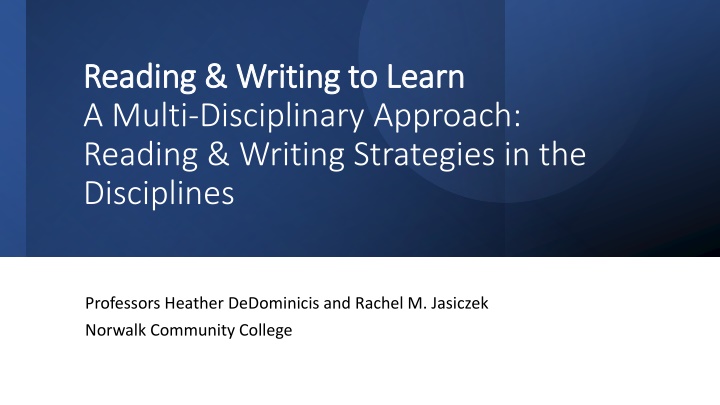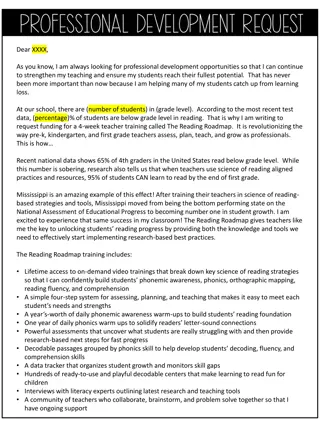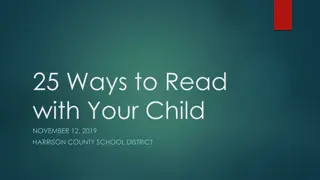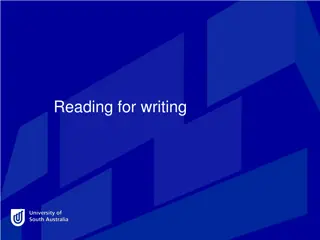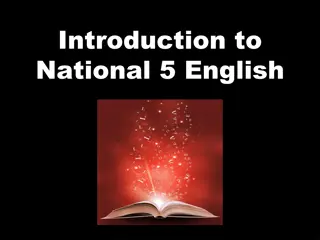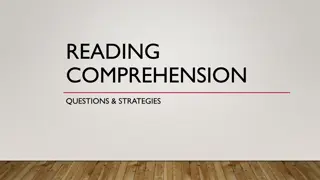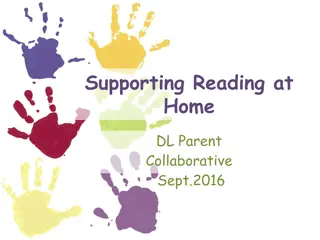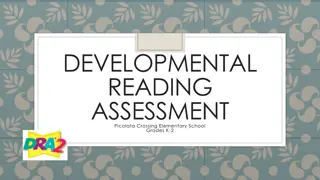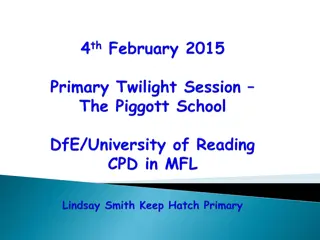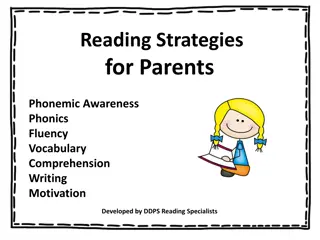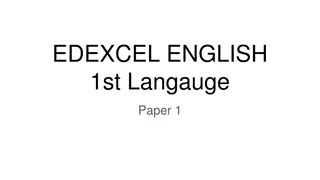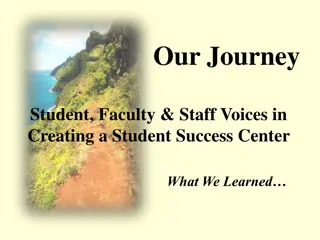Enhancing Reading and Writing Strategies for Student Success
Explore effective reading and writing strategies in a multi-disciplinary approach for student success across all courses. Professors Heather DeDominicis and Rachel M. Jasiczek share crucial tips on engaging students, promoting critical thinking, and creating optimal learning environments. Discover the importance of mindful reading, purpose-driven reading, and strategies to help students become more engaged readers. Join the discussion on fostering a positive learning environment through strategic reading skills.
Download Presentation

Please find below an Image/Link to download the presentation.
The content on the website is provided AS IS for your information and personal use only. It may not be sold, licensed, or shared on other websites without obtaining consent from the author.If you encounter any issues during the download, it is possible that the publisher has removed the file from their server.
You are allowed to download the files provided on this website for personal or commercial use, subject to the condition that they are used lawfully. All files are the property of their respective owners.
The content on the website is provided AS IS for your information and personal use only. It may not be sold, licensed, or shared on other websites without obtaining consent from the author.
E N D
Presentation Transcript
Reading & Writing to Learn Reading & Writing to Learn A Multi-Disciplinary Approach: Reading & Writing Strategies in the Disciplines Professors Heather DeDominicis and Rachel M. Jasiczek Norwalk Community College
Crucial to students success in all courses Reading and Writing to Reading and Writing Simple strategies faculty can implement that have a big impact Demonstrate critical thinking Learn Engage students in the learning process
Heather DeDominicis Heather DeDominicis Developmental English Professor First Year Experience FYE Professor Coordinator of the Transitional Strategies Course Educational Background M.Ed. in Literacy Education ~University of Pennsylvania Email: hdedominicis@ncc.commnet.edu
The Importance of Creating an Optimal Setting for Reading when students read or study in a positive learning environment, they have been shown to be more motivated, engaged, and have a higher overall learning ability. Reading with a Purpose - when students understand the purpose for why they are reading, it can have many benefits. Some examples are: Reduces becoming overwhelmed Promotes focus Improves comprehension Recap from Part 1: Reading to Engage
Agenda: Reading in the Disciplines 2:30 - 3:15 pm Strategies for Mindful Reading Small Group Discussion Large Group Discussion
Quick Insight on Reading Quick Insight on Reading We need to help our students be mindful readers. Those who are aware of their own purposes for reading and of their own thinking process during reading. (Bean & Melzer 134)
Whats a reading strategy you use to help you understand challenging text? Question for the chat:
Suggested Strategies for Helping Students Become More Mindful Readers
Although there are occasions when quizzes may be appropriate, they tend to support surface rather than deep reading Quizzes encourage students to extract the right answers from the text rather than to engage with the text s ideas Limit quizzes to motivate reading
Lecturing over readings can create a vicious cycle Of course, teachers still need to help with difficult portions of a reading But, teachers should send the signal that interacting and engaging with the parts of the text needs to be accomplished as homework Avoid lecturing over readings
Insider vs Outsider. Students are not always the intended audience Without encouragement from teachers, students often feel incompetent when they fail to understand a text I had trouble with this text because I m an outsider vs I had trouble with this text because I m a poor reader Help students see why text can be difficult
Students need to see skilled readers marked up text, marginal notes, and note-taking systems Model this for students Explain what/why you are underlining or writing marginal notes about etc Let them see visually the way you interact with a text Show your own note- taking and responding process
Students reading comprehension increases when they are engaged with the text Awaken students curiosity about upcoming readings Arouse students interest in a text before they read it by having them: Make predictions Make connections Answer or ask questions
Reading guides steer students through particularly difficult material in an organized step by step process These guides may: Fill in background knowledge Have students write their responses to several guided questions Encourage reflection Create Reading Guides
Small Group Discussion In small groups, discuss the following: Does it seem practical or useful to your course to move beyond reading quizzes and lecturing over the reading? Of the strategies suggested, which one(s) do you feel may be useful to incorporate into your course? What strategies or assignments do you already use to promote mindful reading? What changes or results might you expect from students comprehension after applying a best practice to promote mindful reading?
Rachel Milloy Jasiczek Rachel Milloy Jasiczek Writing Across the Curriculum Coordinator, NCC Educational Background Assist faculty in all disciplines to integrate more/effective writing activities and assignments that engage students. Promote a cultural shift in how writing is perceived and valued by demystifying writing instruction. B.A. in Professional Writing M.A. in English/Teaching Composition Encourage all faculty to see reading and writing instruction as a shared responsibility. Ph.D. in Rhetoric and Professional Communication Email: rjasiczek@ncc.commnet.edu
Writing to Learn (WtL) Short, impromptu or otherwise informal and low- stakes (ungraded) writing tasks to introduce concepts and make connections. Recap from Part 1: Writing to Engage Writing to Engage (WtE) Using writing to solve problems or gain greater control of the concepts, conceptual frameworks, skills, processes, and issues addressed in a course. Writing in the Disciplines (WiD) Learning to write rhetorically using discipline- specific genres for specific audience; introduce students to the thinking and writing/language or genre of that discipline.
Agenda: Writing in the Disciplines 3:15 4:00 pm Opening Activity: Best & Worst Assignments Best Practices for Formal Writing Assignments Small Group Discussion Large Group Discussion
The Best The Best Assignment You Assignment You Ever Completed Ever Completed Think of one word/phrase to describe what made it the best.
The Worst The Worst Assignment You Assignment You Ever Completed Ever Completed Think of one word/phrase to describe what made it the worst.
Quick Facts on Writing Quick Facts on Writing Using extensive data compiled from NSSE surveys at a variety of institutions, the researchers conclude that the use of writing to promote deep learning depends less on the amount of writing assigned in a course than on the design of the writing assignment themselves. (Anderson, Anson, Gonyea, and Paine summarized in Bean & Melzer 64)
Quick Facts on Writing Quick Facts on Writing Article Considering the Effects of Assignment Choices on Equity Gaps by Hobbs, Singer-Freeman, & Robinson Compared underrepresented minorities (URM) & non-URM students at a university Largest equity gaps for multiple choice exams and formal writing assignments
But wait . . . But wait . . . The research shows writing The research shows writing is the most effective way to is the most effective way to increase engagement and increase engagement and promote deep learning, promote deep learning, right? right?
Best Practices for Designing Writing Assignments
Let students know what they will be able to demonstrate about their learning by completing the assignment Prioritize 3 4 learning outcomes per assignment Outcomes can indicate the specific skills students should demonstrate and/or connect to larger course outcomes
Include brainstorming and planning activities Incorporate a feedback loop between peers and/or instructor Encourage use of writing tutors Require multiple drafts & reflections
Promote critical thinking Write about problems that matter to the student Situate the assignment within a discourse community or rhetorical situation (audience, purpose, subject/relevance)
Connect to students past and current experiences Connect to class notes & discussions Connect to students future goals (personal, academic, professional) Connect to material learned in other classes Offer metacognitive learning opportunities (think about their own thinking)
Make the purpose clear Indicate the type of writing students should complete Define common terms for students Provide grading criteria along with the instructions Grade a sample paper in class
Give students choice in demonstrating their learning Allow students to explore a topic they are passionate about Offer a revision option for those who want to strengthen their writing/thinking skills Develop grading rubrics together
Small Group Discussion Please review the Sample Formal Writing Assignment. In small groups, discuss the following: Do you see each best practice applied? If not, what improvements might you make to this assignment? Is the assignment student-friendly? Does it have utility value and give students confidence that they can succeed? Which best practices do your own assignments currently employ and which could you more effectively implement?
Save the Date! Plan to Participate! Workshop #3: Showcase for Reading and Writing to Learn January 10th from 2:30 4:00 pm via WebEx The final R&W2L workshop will consist of a showcase of emerging and best practices from faculty across CT State that center on the activities used to support students ability to read and write well in their classes regardless of their discipline. We will be inviting faculty and staff from across the system to submit proposals later in the Fall 2022 semester to participate in this event!
